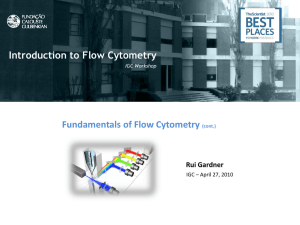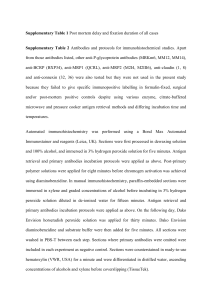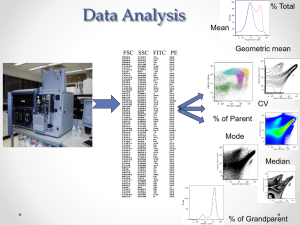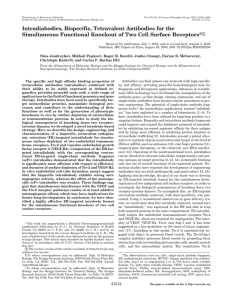High-throughput screening of single
advertisement
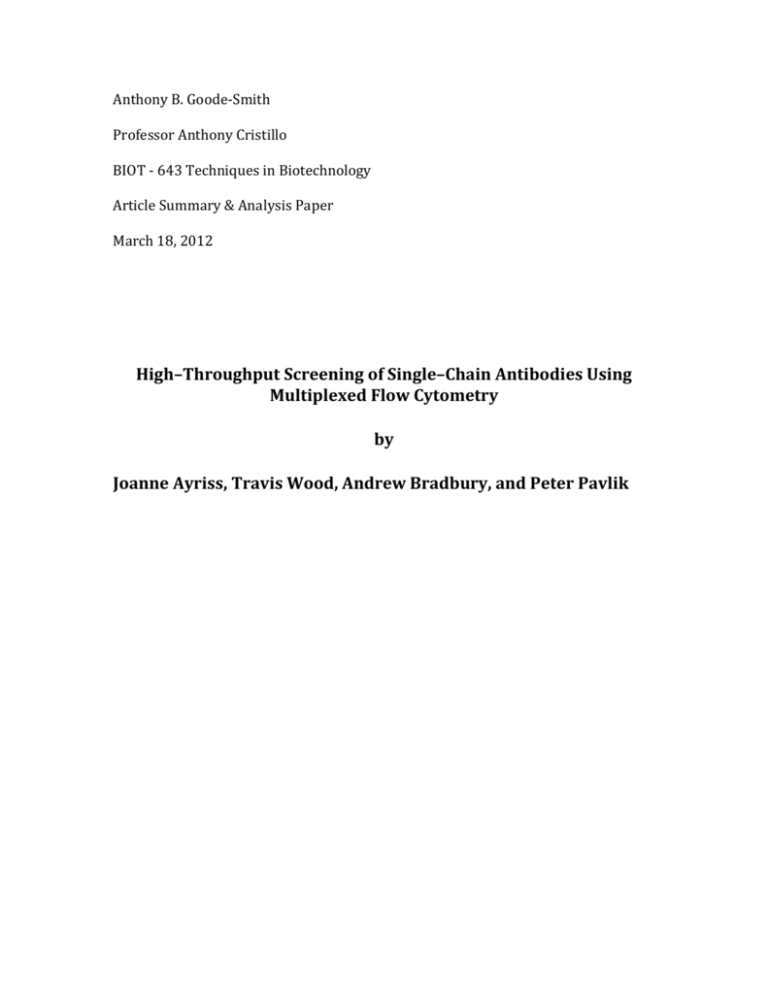
Anthony B. Goode-Smith Professor Anthony Cristillo BIOT - 643 Techniques in Biotechnology Article Summary & Analysis Paper March 18, 2012 High–Throughput Screening of Single–Chain Antibodies Using Multiplexed Flow Cytometry by Joanne Ayriss, Travis Wood, Andrew Bradbury, and Peter Pavlik Background: Proteomics is desperately seeking superior quality well-verified antibodies. Researchers are facing a common dilemma in finding single–chain antibodies targets that match a small number of proteins in the human genome. In the article High-Throughput Screening of Single-Chain Antibodies Using Multiplexed Cytometry, the author(s) Joanne Ayriss, et al., explain how they have constructed a novel screening method that is more efficient in the high-throughput analysis of reagents used in the study of proteins. In addition, the author(s) also mention that essentially by utilizing multiplexed flow cytometry results in the whole profile of a clone that is derived by expression levels, rates of non-specific binding, and the discrete selection of fine specificities. Moreover, the Article primarily focuses on the premise of utilizing multiplexed flow cytometry technology, which has major advantages and distinctions in contrast to the conventional ELISA method. For instance, multiplexed flow cytometry is vastly more efficient on time versus ELISA , mainly because multiplexed flow cytometry initially gathers more content in the first screen than subsequent screenings. The author(s) also make a strong case in that bundling high-throughput screenings along with multiplex flow cytometry has in fact, enhanced the process of analysis of affinity reagents that originate from combinatorial libraries and ease the overall large scale proteomic analysis 2 Main Idea: Arysiss’ et al., primary focus is a significant increase of combinational libraries for the production of phage antibodies that binds to affinity protein targets. Prior to multiplexed flow cytometry, there is the standard ELISA/ microassay method, which is a practical analytical assessment, but they are slow and laborious in terms of processing. Thus, creating a need for a more efficient quick highthroughput system that is capable of processing unique binders to a rapid form assessment with critical accuracy. Arysiss et al. (2006) The author(s) also mentioned that there are numerous advantages between multiplexed flow cytometry and previously used standard methods of screening, such as data processing time, reproducibility, storage, and antigen use. (2006) Multiplex Flow Cytometry is widely being used to characterize mAbs that distinguish varying epitopes. (2006) Moreover, Multiplex Flow Cytometry technology has highly expanded the functionality of high-throughput screening of specific antibody analysis. (2006) With the serious interest in proteomics, antibodies have become a worldwide commodity in research projects. Blow, N. (2007) Discussion: The methodology and preparation of multiplex flow cytometry is as follows: Biotinylated Antigens Purified lysozymes deducted from egg whites of duck, turkey and quail, and processed via ionic exchange chromatograpy. Ayriss etal. (2006) The sonication 3 process occurred with the egg whites at 50 mM buffer pH = 9.2 then centrifugation…21000g….filtration via 0.45um syringe. (2006) The molecules are then put on a HighS column to be eluted with NaCl substance. (2006) Several commercial assay kits were used to analyze activity…BCA Protein Assay Kit, EnzChek Lysozyme Assay Kit, EZ Biotin Quantification Kit. Approximately four lysozmes along with ubiquitin and alcohol dehydrogenase (ADH)…went through biotinylation in order to conjugate molecules to a range of 1-2 biotins. (2006) Microsphere-Bead Multiplex A microsphere set comprised of eight varying colors from a commercial vendor called Luminex were used. (2006) The microsphere set was paired with Neutraivdin (2006) Biotinylated monomeric azami green (Mag) fluorescent protein, which was used to measure the amount of neutravidin paired to each bead set. (2006) (see Fig.1) This was followed by an incubation of 1hour at room temperature, the 200 uL microsphere set containing 40nM biotinylated antigen in last batch of 2.5mL. Then the microspheres were purified twice with PBS, and 0.05% Tween 20 and subsequently re-suspended in 200 uL of PBS. A 1600 uL multiplex was formed from a combination of antigen-paired microspheres for assessment of 100 ScFv prototypes. (2006) This further deducted analysis could occur by using 16 mL of multiplex for assessment of one ScFv prototype. (2006) Flourescently Labeled scFv’s Utilizing large scFv phage libraries were performed on the biotinylated chicken lysozyme via an automated processing and biopanning called Kingfisher 4 magnetic bead system from the commercial vendor (Thermo Lab Systems), (2006) Streptavidin magnetic beads were combined with the solution of biotinylated antigens. This panning process was repeated three times, reducing the antigen amount 10 times in the second processing, and purified (1, 5, 15) minutes on each cycle. (2006) Subsequently after the third round of …output, the DNA was extracted and cloned into the pEP-Ecoil vector, then ligated and configured into BL21 Gold Electrocomponent cells. Thus ….clones were chosen on kanamycin plates. (2006) This was followed by placement of a sheet covering called Airepore (Qiagen no.19571) Subsequently, incubation for 36 hours at 18 degrees C with concomitant shaking. (900 rpm) The expressed sample was extracted by media supernatant via centrifugation (4000 rpm) during 30 minutes. (2006) Utilizing K-coil attached to Alexa488, the scFv proteins were fluorescently tagged for final concentration at room temperature for approximately 1 hour, then combined with16uL of multiplex. Further purification is not necessary before final assessment. (2006) Multiplexed Analysis of Binding Ligands Using the LSRII Flow Cytometer Utilizing the Becton Dickinson LSRII Flow Cytometer and DIVA software calculated the mean fluorescence information of individual bead sets within the multiplex. (2006) The Mean fluorescence value was determined by gates of excitation using a 633 nm laser via APC-cy7 (780/60BP) and APC (660/20BP) detectors. The sum of 25 uL of each prototype was inserted at…0.5ul/s and the 5 mean fluorescence of approximately 5000 scattered, … microspheres was assessed. (2006) Flow Cytometric Data Analysis The Multiplex breakdown analysis is comprised of the calculated mean fluorescence data in each microsphere set. Moreover, in order to account for the variance in expression levels juxtaposed to the scFv’s, the mean fluorescence was divided into the assigned SV5 value and then changed to a percentage of the initial SV5 value. (2006) An identification is evident if the mean fluorescence data is three fold or greater than average background. (2006) Surface Plasmon Resonance Analysis of scFv’s Q4F4 and Q2E5 Utilizing the Biacore 2000 (Biacore), Surface plasmon resonance analysis was performed. Biacore Streptavidin chip was covered via four consecutive cycles with biotinylated chicken, quail, and turkey lysozyme. (2006) Purification of the Q4F4 and Q2E5 scFv proteins with the primary flow cell free of paired antigen was assigned as the negative control. (2006) It was subsequently placed on a Ni-NTA chromatography and diluted to end point concentration of 200nM with 1uM in HBPS buffer. (2006) ELISA Analysis of scFv Binding Ligands Utilizing a Tecan genesis 2000 workstation (Tecan) the ELISA was conducted. 384 Maxisorp wells were pre-coated with 50 uL of 10 ug/mL neutravidin, purified with PBS-LT, and stabilized with 100 uL of 1% BSA for 1 hour, followed by plate washing then adding 50 uL of anti-SV5 mouse monoclonal incubated at room temperature. The cycle was repeated with secondary Anti-Mouse 6 IgG-Alkaline Phosphatase (AP). (2006) The utilization of the SPECTRAfluor & spectroflurometer, and laser at 405nm binding activity was observed after treatment with 80 uL of AP substrate. (2006) Conclusion: Ayriss et al. has formulated a screening method that has the ability to make high-throughput assessments more efficient. (2006) According to the author(s), Multiplex flow cytometry (MFC) offers a viable choice in screening modality versus standard options. (ELISA, microarrays) (2006) Moreover, Multiplexed technology has rendered results in high-throughput assessments that produced regular outputs. (2006) MFC technology also has important uses in mAb research and choosing foundations for antibody libraries. Hoogenboom H. (2005) Furthermore, other innovations in high-throughput screening have resulted from MFC technology such as the “Human Combinatorial Antibody Library (HuCAL®)”. Krebs, B. (2001) The “HuCAL® is a single-chain Fv-based phage display library, which HuCAL® principle enables the rapid and high-throughput development of human antibodies by optimization strategies proven useful in classical low molecular weight drug development.” Krebs, B. (2001) The major advantage of Multiplexed flow cytometry over standard ELISA, microarrays analysis is that Multiplexed technology demonstrates more efficiencies in terms of antigen use, and assessment periods. Finally, the author(s) make the premise that incorporating high-throughput screening with multiplexed technology 7 will revolutionize the rules for primary identification of novel binding ligands gathered from combinatorial libraries. (2006) Critical analysis: In my opinion, the author(s) Ayriss et al., have presented a rather strong case for using Multiplexed flow cytometry for high-throughput screening analysis mainly because as this Article clearly illustrates significant advantages over utilizing standard ELISA /microarray assessment modalities and gathering the data in the primary screen juxtaposed to the second, or third, which saves time and resources, such as, antigen consumption, buffer solution, etc. Moreover, the anecdotal data results (table 1) supports the premise statement presented in the abstract section that the combination of high-throughput screening capabilities with multiplexed technology are redefined. Thus, the guidelines for the initial identification of affinity reagents are recovered from combinatorial libraries. In addition, I enjoyed reading this Article because it showed the relevance and importance of Multiplexed flow cytometry in high-throughput screenings, particularly in single-chained antibodies which there seems to be a measurable gap in proteomics. Researchers need to focus on closing the gap in order to effectuate change in comprehensive antibody therapy research to cure serious diseases. However, I did not find any significant disadvantages presented in this Article. I believe this Article has furthered the capabilities and efforts of researchers in 8 streamlining high-throughput screening for proteomics and adds efficiency to the field of biotechnology in general. Graphics: Table 1. Comparison of Parameters Required by ELISA and BD LSRII Flow Cytometer for Ligand Binding Analysis Parameters of screening system LSRII Flow Cytometry ELISA Volume of scFv culture supernatant per sample 50 íL 50 íL Number of replicates for each antigen per scFv sample 500 1 Minimum amount of each antigen (15 kDa) needed to screen 1 scFv sample 0.015 íg 1 íg Minimum amount of each antigen (150 kDa) needed to screen 1 scFv sample 0.15 íg 1 íg Minimum amount of each antigen (15 kDa) needed to screen 96 scFv samples 1.5 íg 96 íg Minimum amount of each antigen (150 kDa) needed to screen 96 scFv samples 15 íg 96 íg Can the screening system accommodate multiplexing? Yes No Can prepared samples be stored? If so, for how long? Yes; Upto 14 days at 4 °C No Time to screen 96 samples 30 min 3 9 References: Ayriss, J. et al. (2006), High-throughput screening of single-chained antibodies using multiplexed flow cytomerty, Journal of proteome research Volume 6, No. 3, 200 Biosciences Division Mail Stop M888, Los Alamos National Laboratory, P.O. Box 1663 Los Alamos, New Mexico 87545 Blow, N. (2007) Antibodies: the generation game, Nature 447, 741-744 doi: 10.1038/47741a; Published online 6 June 2007 Hoogenboon, H. (2005) Selecting and screening recombinant antibody libraries, Nature biotechnology nature Publishing Group, retrieved from: http://www.chemie.uni-hamburg.de/bc/lehre/Review_I_Hoogenboom_2005.pdf Krebs, B. (2001), High-throughput generation and engineering of recombinant human antibodies, Journal of immunological methods Volume 254, Issues 1-2, 1 August 2001, Pages 67-84, Retrieved from: http://www.sciencedirect.com/science/article/pii/S0022175901003982 10 11

